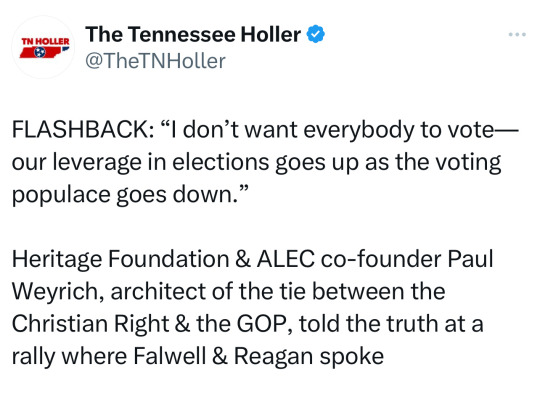#This is Bob Jones University
Explore tagged Tumblr posts
Photo

Bi-Lo Supermarkets took out a full-page ad in the 1967 special insert in the Greenville News with the copy:
Shopping at BI-LO's means friendly, good neighborly service -- meats specially cut for your individual taste -- large selections of quality products and that extra warm familiar spirit that BI-LO's personnel offer.
BI-LO's many locations make it easy for you to reach . .. easy to park . .. easy to shop. Just like we've been saying all along! Try us! You'll find, like everyone else has . . . THERE'S NO PLACE ON WORTH LIKE BI-LO's!!!
Those are BJU Home Ec majors in the picture.
#Bob Jones University#1967#Greenville News#YeahTHATGreenville#Advertisement#Anniversary#Bi-Lo#Supermarket#Home Economics Majors#This is Bob Jones University
5 notes
·
View notes
Text

One of the most durable myths in recent history is that the religious right, the coalition of conservative evangelicals and fundamentalists, emerged as a political movement in response to the U.S. Supreme Court’s 1973 Roe v. Wade ruling legalizing abortion. The tale goes something like this: Evangelicals, who had been politically quiescent for decades, were so morally outraged by Roe that they resolved to organize in order to overturn it.


This myth of origins is oft repeated by the movement’s leaders. In his 2005 book, Jerry Falwell, the firebrand fundamentalist preacher, recounts his distress upon reading about the ruling in the Jan. 23, 1973, edition of the Lynchburg News: “I sat there staring at the Roe v. Wade story,” Falwell writes, “growing more and more fearful of the consequences of the Supreme Court’s act and wondering why so few voices had been raised against it.” Evangelicals, he decided, needed to organize.
Some of these anti- Roe crusaders even went so far as to call themselves “new abolitionists,” invoking their antebellum predecessors who had fought to eradicate slavery.
But the abortion myth quickly collapses under historical scrutiny. In fact, it wasn’t until 1979—a full six years after Roe—that evangelical leaders, at the behest of conservative activist Paul Weyrich, seized on abortion not for moral reasons, but as a rallying-cry to deny President Jimmy Carter a second term. Why? Because the anti-abortion crusade was more palatable than the religious right’s real motive: protecting segregated schools. So much for the new abolitionism.
Today, evangelicals make up the backbone of the pro-life movement, but it hasn’t always been so. Both before and for several years after Roe, evangelicals were overwhelmingly indifferent to the subject, which they considered a “Catholic issue.” In 1968, for instance, a symposium sponsored by the Christian Medical Society and Christianity Today, the flagship magazine of evangelicalism, refused to characterize abortion as sinful, citing “individual health, family welfare, and social responsibility” as justifications for ending a pregnancy. In 1971, delegates to the Southern Baptist Convention in St. Louis, Missouri, passed a resolution encouraging “Southern Baptists to work for legislation that will allow the possibility of abortion under such conditions as rape, incest, clear evidence of severe fetal deformity, and carefully ascertained evidence of the likelihood of damage to the emotional, mental, and physical health of the mother.” The convention, hardly a redoubt of liberal values, reaffirmed that position in 1974, one year after Roe, and again in 1976.
When the Roe decision was handed down, W. A. Criswell, the Southern Baptist Convention’s former president and pastor of First Baptist Church in Dallas, Texas—also one of the most famous fundamentalists of the 20th century—was pleased: “I have always felt that it was only after a child was born and had a life separate from its mother that it became an individual person,” he said, “and it has always, therefore, seemed to me that what is best for the mother and for the future should be allowed.”
Although a few evangelical voices, including Christianity Today magazine, mildly criticized the ruling, the overwhelming response was silence, even approval. Baptists, in particular, applauded the decision as an appropriate articulation of the division between church and state, between personal morality and state regulation of individual behavior. “Religious liberty, human equality and justice are advanced by the Supreme Court abortion decision,” wrote W. Barry Garrett of Baptist Press.
So what then were the real origins of the religious right? It turns out that the movement can trace its political roots back to a court ruling, but not Roe v. Wade.
In May 1969, a group of African-American parents in Holmes County, Mississippi, sued the Treasury Department to prevent three new whites-only K-12 private academies from securing full tax-exempt status, arguing that their discriminatory policies prevented them from being considered “charitable” institutions. The schools had been founded in the mid-1960s in response to the desegregation of public schools set in motion by the Brown v. Board of Education decision of 1954. In 1969, the first year of desegregation, the number of white students enrolled in public schools in Holmes County dropped from 771 to 28; the following year, that number fell to zero.
In Green v. Kennedy (David Kennedy was secretary of the treasury at the time), decided in January 1970, the plaintiffs won a preliminary injunction, which denied the “segregation academies” tax-exempt status until further review. In the meantime, the government was solidifying its position on such schools. Later that year, President Richard Nixon ordered the Internal Revenue Service to enact a new policy denying tax exemptions to all segregated schools in the United States. Under the provisions of Title VI of the Civil Rights Act, which forbade racial segregation and discrimination, discriminatory schools were not—by definition—“charitable” educational organizations, and therefore they had no claims to tax-exempt status; similarly, donations to such organizations would no longer qualify as tax-deductible contributions.
On June 30, 1971, the United States District Court for the District of Columbia issued its ruling in the case, now Green v. Connally (John Connally had replaced David Kennedy as secretary of the Treasury). The decision upheld the new IRS policy: “Under the Internal Revenue Code, properly construed, racially discriminatory private schools are not entitled to the Federal tax exemption provided for charitable, educational institutions, and persons making gifts to such schools are not entitled to the deductions provided in case of gifts to charitable, educational institutions.”
Paul Weyrich, the late religious conservative political activist and co-founder of the Heritage Foundation, saw his opening.
In the decades following World War II, evangelicals, especially white evangelicals in the North, had drifted toward the Republican Party—inclined in that direction by general Cold War anxieties, vestigial suspicions of Catholicism and well-known evangelist Billy Graham’s very public friendship with Dwight Eisenhower and Richard Nixon. Despite these predilections, though, evangelicals had largely stayed out of the political arena, at least in any organized way. If he could change that, Weyrich reasoned, their large numbers would constitute a formidable voting bloc—one that he could easily marshal behind conservative causes.
“The new political philosophy must be defined by us [conservatives] in moral terms, packaged in non-religious language, and propagated throughout the country by our new coalition,” Weyrich wrote in the mid-1970s. “When political power is achieved, the moral majority will have the opportunity to re-create this great nation.” Weyrich believed that the political possibilities of such a coalition were unlimited. “The leadership, moral philosophy, and workable vehicle are at hand just waiting to be blended and activated,” he wrote. “If the moral majority acts, results could well exceed our wildest dreams.”
But this hypothetical “moral majority” needed a catalyst—a standard around which to rally. For nearly two decades, Weyrich, by his own account, had been trying out different issues, hoping one might pique evangelical interest: pornography, prayer in schools, the proposed Equal Rights Amendment to the Constitution, even abortion. “I was trying to get these people interested in those issues and I utterly failed,” Weyrich recalled at a conference in 1990.
The Green v. Connally ruling provided a necessary first step: It captured the attention of evangelical leaders , especially as the IRS began sending questionnaires to church-related “segregation academies,” including Falwell’s own Lynchburg Christian School, inquiring about their racial policies. Falwell was furious. “In some states,” he famously complained, “It’s easier to open a massage parlor than a Christian school.”
One such school, Bob Jones University—a fundamentalist college in Greenville, South Carolina—was especially obdurate. The IRS had sent its first letter to Bob Jones University in November 1970 to ascertain whether or not it discriminated on the basis of race. The school responded defiantly: It did not admit African Americans.
Although Bob Jones Jr., the school’s founder, argued that racial segregation was mandated by the Bible, Falwell and Weyrich quickly sought to shift the grounds of the debate, framing their opposition in terms of religious freedom rather than in defense of racial segregation. For decades, evangelical leaders had boasted that because their educational institutions accepted no federal money (except for, of course, not having to pay taxes) the government could not tell them how to run their shops—whom to hire or not, whom to admit or reject.
The Civil Rights Act, however, changed that calculus.
(continue reading)
#politics#republicans#paul weyrich#abortion#religious riech#bob jones university#jerry falwell#christian nationalism#white supremacy#desegregation#project 2025#roe v wade#reproductive rights#reproductive justice#healthcare#brown v board of education#heritage foundation#moral majority#religious freedom#religion
195 notes
·
View notes
Text
May's collection of fan art. I was a lot prepared this month.

All the characters I Kin. Originally without Terrence, Bluey, Edd, and King Dice, but at the end of the day, I couldn't leave those four out. Took basically a week or so to finish.

Two douch bags i felt like drawing. "The Plan (F**k Jobs)" by The Front Bottoms reminded me of them somewhat. Especially Ram.


These two had birthdays this month, so I drew these. I was wrong about Denzel having a birthday in March.
(HC) Pinkie looks forward to her growth while Denzel is feeling depressed because of it. I'll probably draw a better birthday drawing for Denzel later on (most likely next year).

I finally got to listen to the Apple Sleep Experiment sequel. This was drawn during a relisten of the first one. I was trying to draw the sequel version, but I wasn't sure.

This is a drawing for my mom for Mother's Day. She cried from seeing it. Especially the words. (which were from the Valentine's special from EEnE but i thought it was perfect for this piece.)
I'm so glad she loved it :)
I got an idea for Father's Day, too.

"Imagine drawing May 1st art at the end of May. Lmao couldn't be me." Couldn't include May from Twelve/Origins, but I don't think anyone would really worry about that anyway.
Extras without extra stuff:



Personally, I like these. Possibly more than the ones with words and reference pictures. What do you think? I think they're much cleaner, idk.
I had a lot done towards the beginning of the month, so I was actually prepared this time. I'm really glad for all of these, especially the Mother's Day fan art.
Even the people at my program were impressed, and someone even asked if I did commissions. I said that I hadn't been thinking about it. They said they would pay me to draw something for a relative of theirs, but I haven't been talking to them about it since.
Overall, though, I'm just glad that I'm getting better at drawing anything. I've also been looking through my old art recently, and yup, a lot of my style has changed.
I was even drawing some old characters into my recent work. Idk if any of you want to see them, tho. I would like to compare my first time drawing them to my latest time, I just need to find my old old work.
But yeah, thanks for viewing my art and reading my rants. Y'all are awesome! Cya around. I'm looking forward to drawing some Total Drama and That's Not My Neighbor fan art next month. 😁✨️
#multifandom#camellia salazar#waluigi#mfn norman#crona gorgon#denzel crocker#frank grimes#clay puppington#steven universe#eene eddy#fred jones#jon arbuckle#bob belcher#terrence fhfif#bluey heeler#ew edd#king dice#heathers#heathers: the musical#mlp#apple sleep experiment#birthday art#mother's day#may 1st#fan art#self insert#kin list#i kinda miss posting throughout the month and not just having it at the end#also looking back at some old doodles make me miss the time when i would just doodle the characters fucking around lol#cw blood
48 notes
·
View notes
Text

Looking at these tags I just made on a Bible related post…damn.
Forgot also to mention that in college if you didn’t go to at least 2 church services a week more than three times you’d get disciplinary action.
I hope Bob Jones University burns to the ground.
#bob jones university#ex evangelical#very happy and pleased every time I realize I’ve forgotten a Bible fact
5 notes
·
View notes
Note
is king lear worth watching? a 4h play recording seems like a lot but i saw those gifs of shirtless luke so i’m kind of interested 👀
the NTL king lear is only about two hours, actually, and it's a really good introduction to the play as a whole! unfortunately i don't remember where i acquired my copy so you'd have to go hunting on your own. @suits-of-woe or @butchhamlet might be able to help.
edit: I unintentionally lied here, my NTL recording comes in two parts, which adds up to a little over three hours. That's about typical for this play, and comparable to Hamlet and Much Ado
if you just want a free available production of the play, i cannot recommend the Bob Jones University production highly enough!! it's the first full production i ever saw (runs two hours 44 minutes) and it has an incredible cast and a very clear conceit for a post-civil war setting edging into the industrial age, playing with a society in turmoil where no one knows the rules. Edmund is charismatic and Edgar's uncertainty brings him through terror into self-invention, and they do some really fun things with the lighting and choreography.
8 notes
·
View notes
Text


W A T C H I N G
#BATMAN & MR FREEZE SUBZERO (1998)#batman the animated series#Michael Ansara#Kevin Conroy#Loren Lester#Mary Kay Bergman#George Dzundza#Efrem Zimbalist Jr.#Bob Hastings#Robert Costanzo#Marilu Henner#Dean Jones#Liane Schirmer#DC COMICS#BATMAN#MR FREEZE#BATGIRL#DCAU#DC ANIMATED UNIVERSE#WATCHING
46 notes
·
View notes
Text


Bob Jones University GRACE Report - Recommendations for Jim Berg
0 notes
Text



More pictures from Bob Jones University's 2nd Annual Animation Camp! David, Michael, and Sophia all had a blast last week. Looking forward to next year!
#christian#brainy pixel#animation#2d#3d principles of animation#learn to animate#bob jones university#animation camp
0 notes
Photo

Old Colony Furniture’s headline is, “This is Bob Jones University.”
WutBJU says that a lot. But the copy here is curious:
The contribution made to the economy of Greenville by resident faculty members of BJU, and the large number of married students cannot be denied. With this in mind, Old Colony Furniture Company stays in step with the changing styles of new household furniture.
Old Colony is a little high-end for BJU employees.
#Bob Jones University#1967#Greenville News#YeahTHATGreenville#Advertisement#Anniversary#Old Colony#This is Bob Jones University
2 notes
·
View notes
Photo

Meyers-Arnold was a Greenville staple back in the day.
The origins of the company started with James H. Morgan as a general merchandise enterprise. Morgan sold out to G. Heyward Mahon and J. Thomas Arnold in 1899 and the name was changed to Mahon & Arnold. The company touted itself as “The College Girls’ Store,” catering to the female students of Greenville Women’s College and Chicora College.
#Bob Jones University#1967#Greenville News#YeahTHATGreenville#Advertisement#Anniversary#This is Bob Jones University#Meyers Arnold
1 note
·
View note
Text

While we know that the BJU Press has been funding BJU for years, WutBJU has received new information from BJU Press employees.
The BJU Press is "crumbling."
7 notes
·
View notes
Text
What is BJU anyway?
It stands against "woke ideologies." It's "[politically] conservative but not the angry type."
And it doesn't teach how to read a teleprompter.
5 notes
·
View notes
Text

There's so much to comment on. I don't know where to start.
4 notes
·
View notes
Text

Apparently, the last fiscal year for the BJU Press was disastrous.
WutBJU's internal sources call it a "mess."
Not just internally among employees, but for customers and, especially, for the bottom line.
3 notes
·
View notes
Text

We all know this.
BJU admits this.
When BJU was still a taxable entity and the Press and the school were one corporation, BJU depended upon the Press for 1/3 of its expenses.
And still, the BJU Press funds BJU. Remember what Josh Crockett just said:

3 notes
·
View notes
Text

Nathan Crockett is filling his instagram feed with all sort of Michael-Scott-caliber successories.
But this one about "exit interviews"? Shane Coultor is stating the obvious:
I take it this is for all the faculty who are about to be let go? Praying that enrollment comes up soon praying
Uh oh.
4 notes
·
View notes